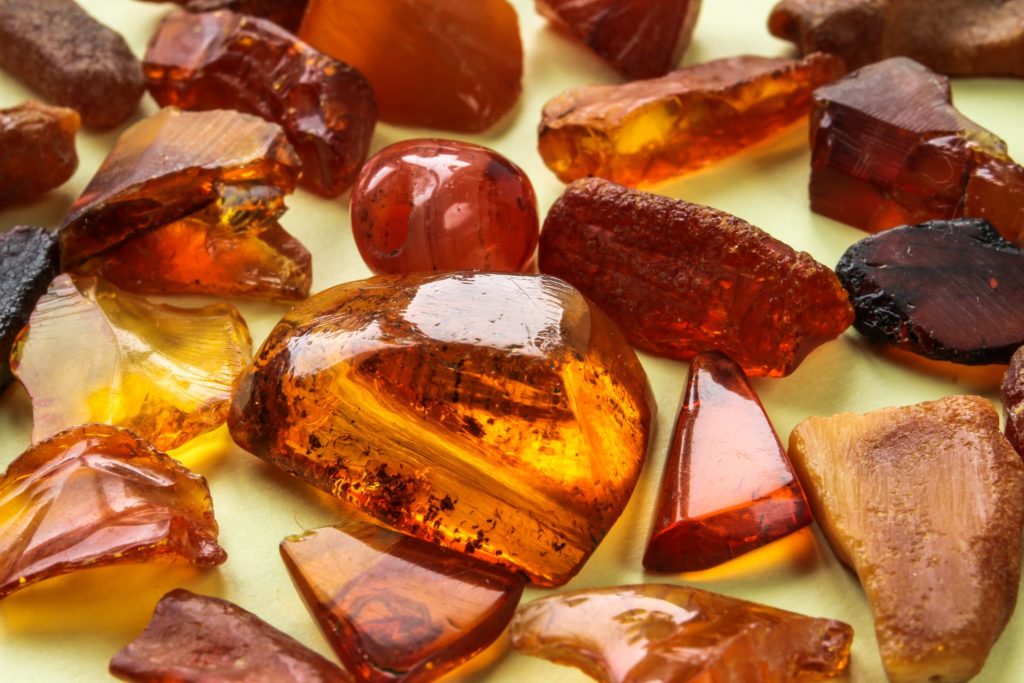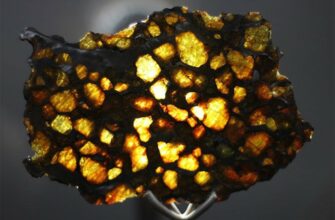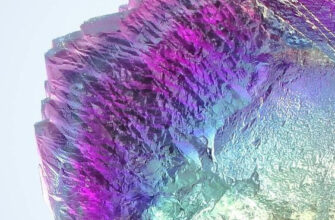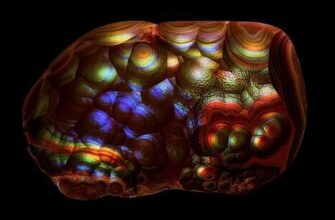Amber stone is one of the most famous and popular, has 300 varieties, is widely used for treatment and rejuvenation, as a talisman. Almost every woman has sun stone jewelry. The history of its appearance is still being discussed by scientists. In today's article, let's talk in more detail about the amazing stone, its origin and characteristics.
What is this stone - description
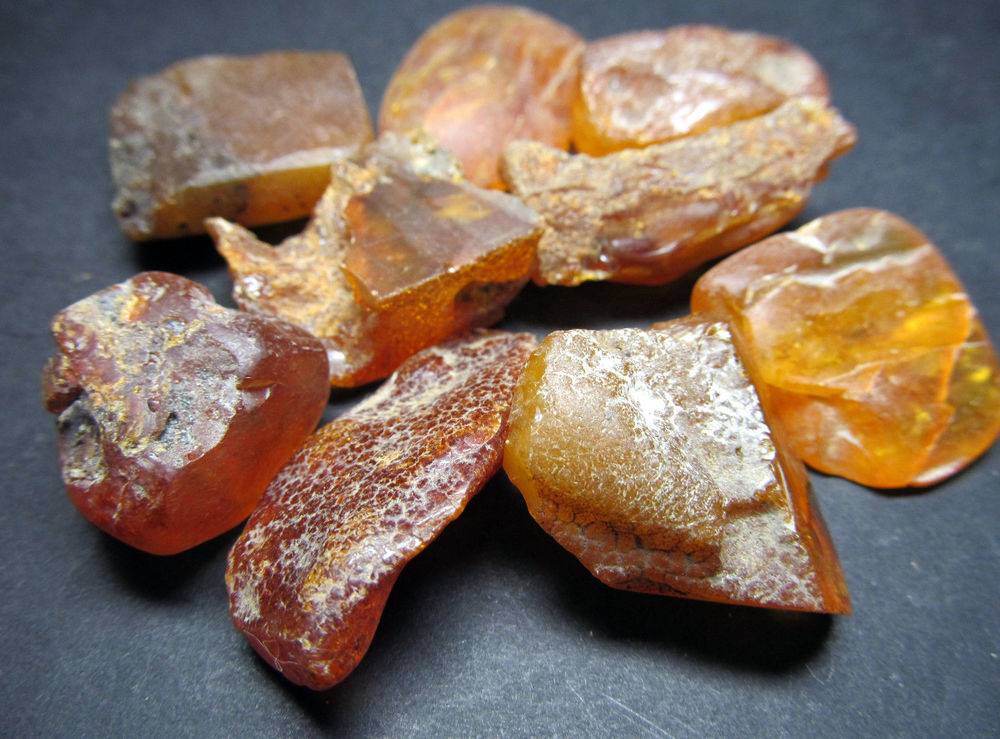
The golden stone with frozen intricate designs, which is used by jewelers, was discovered thousands of years ago, and its history goes back from 35 to 140 million years.
This mineral is the hardened resin of conifers, the so-called sap. Untreated amber has a dull and often opaque appearance.
Only a few specimens have transparency and matte sheen. All stones mined in the mines are classified according to several criteria.
Necessarily taken into account:
- transparency;
- the form;
- blotches;
- the size.
After processing, the stone acquires a brightness of tone, a honey tint, amazing patterns become visible, dark chips are eliminated. As a result, you can see the magic amber that you like so much.
Important: amber is not considered a precious stone, it is a semiprecious mineral.
Although there are varieties and different colors of amber, including even black, the classic shade is considered to be honey, symbolizing joy, youth, light and happiness.
The mineral is used not only for making jewelry, but also in small quantities in pharmaceuticals, chemical and food industries, electronics, and sometimes in perfumery.
Why is it called solar

This definition arose from the golden hue of amber. It really resembles weightless pieces of the sun. The main shades are brown, yellow, white and red.
Previously, it was believed that the more the resin of the trees is illuminated by the sun's rays, the brighter the stone.
The name was also influenced by the myth of Ancient Greece about the reckless Phaeton - the son of the god Helios. The youth was clumsy with the solar chariot and was swallowed up by the waters of the Eridanus River.
The sisters of Phaethon grieved very much for their brother and turned into trees on the shore. And their tears rolled down into the water like golden drops. Therefore, amber can sometimes be found on the shore to this day.
From time immemorial, the sun has been associated by humanity with warmth, strength and joy, protection and activity, therefore the life-affirming golden hue and the magical properties of the amber amber allow us to call it “solar”.
History of the origin of amber
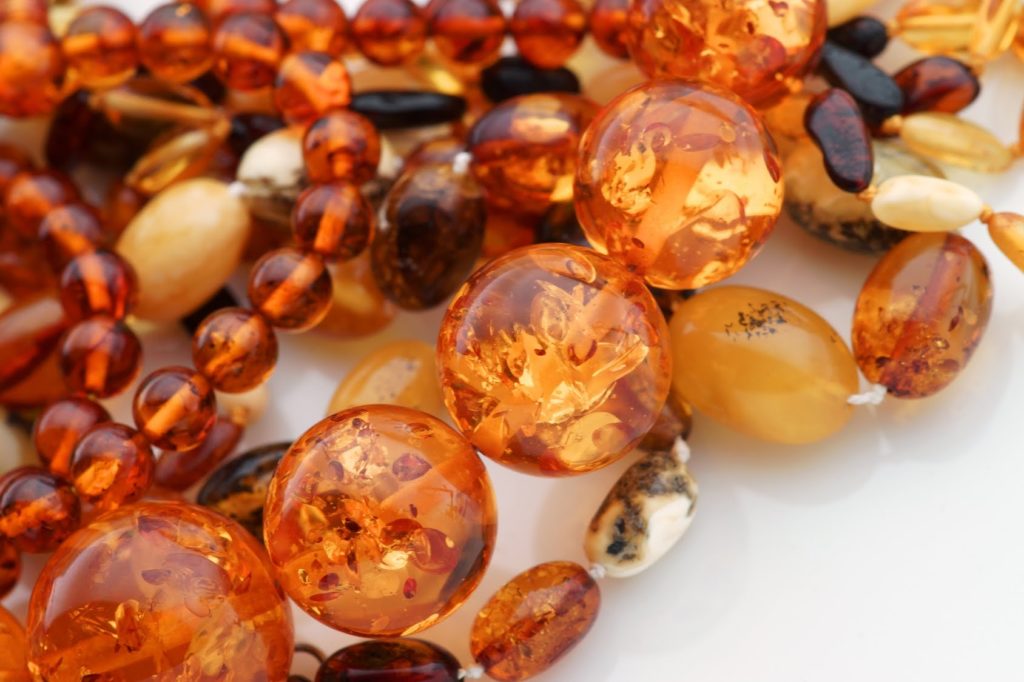
In the museums of London today you can get acquainted with the first mentions of the stone, which date back to the XNUMXth century BC. Even in the Neolithic era, people knew about amber, used it as jewelry and to treat many diseases.
Scientists have long argued about the origin of this amazing stone.
As a result, it was found that amber is really a resin that rolled into the soil and turned into a mineral there.
Amber is considered to be a stone that is at least 1 million years old (the type of wood does not matter according to one of the scientific versions).
Until the XNUMXth century. there were other hypotheses of occurrence:
- This is frozen sea foam.
- Contents of whale stomachs, because amber was often found on the seashore.
- Amber is a special oil that was squeezed out of rocks by giants.
- Honey, only strongly hardened.
- Oil that has turned to stone over the centuries.
Many will ask: And for what reason does resin not turn into amber in the modern world?
The answer to this question is also available: many millions of years ago, relict pines grew on Earth.
When there was a sharp warming, the trees began to actively emit resin, which then turned into a special honey-colored stone.
The value of amber
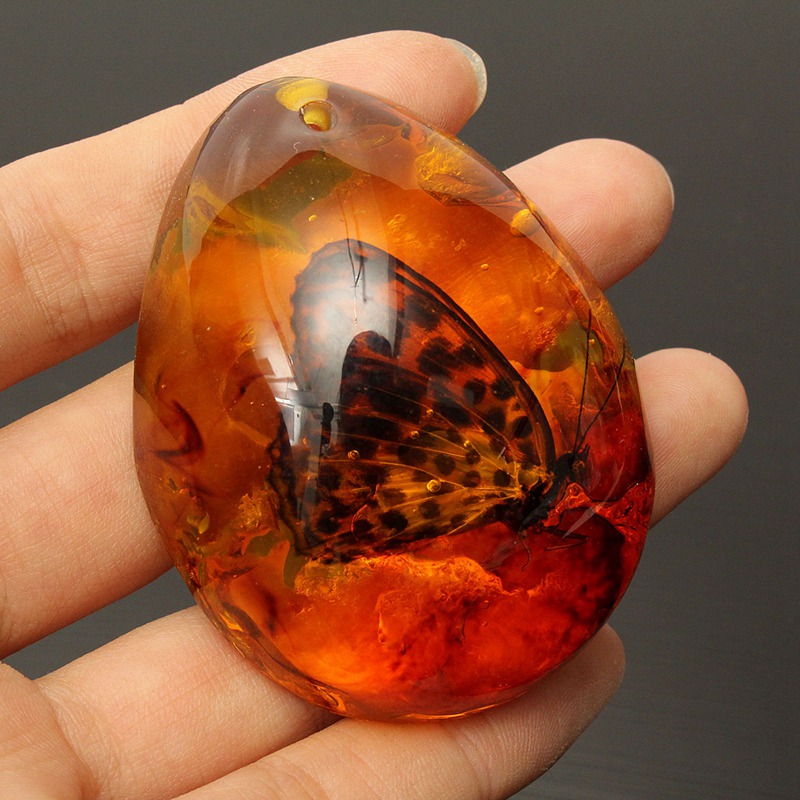
The very name "Amber" was borrowed by the ancient Romans from the Arabic language "ambre".
In Germany, the mineral is called "bernstein", that is, "burning stone" (indeed, at a certain temperature, amber burns with a beautiful red flame and has a pleasant aroma).
In ancient Greece, another name was adopted - electrum and electron ("shining"), in honor of the star Electra, located in the constellation Taurus.
The stone has the same special warm glow. Hence the old Russian name "Ilectron".
In Ukraine, amber was called Burshtyn - “burnt stone”, it was often set on fire and used as incense.
Due to the ability of amber to transmit electricity and become electrified, the mineral in the Arab countries is called Kahraba - “attracting straw”.
How was stone used in ancient times?
- In Egypt made incense burners and used in various rituals, added to the composition of mixtures for the mummification of the dead.
- Ancient romans wore amber jewelry and believed in their protective powers. Amber was a symbol of wealth; only the wealthiest people had it.
- In ancient Greece it was customary to decorate weapons with amber. It was believed that he protects in battles.
- В The Baltic States the mineral is named Dzintars (probably this is where the word “entar” and then Amber came from).
- Avicenna and Hippocrates mentioned in the writings the unique healing properties of the stone. Biruni and Pliny studied the beneficial effects of the mineral on the health of children.
- In China amber is called the soul of the tiger. According to legend, the winged dragon had a soul, and after his death it fell to the ground and turned into a yellowish stone.
Many nationalities considered amber a living stone, they worshiped it and believed in its life-giving and healing power, considered it a symbol of victory.
The peak of amber's popularity came in the XNUMXth century, when jewelry for the nobility was made from it. The Amber Room from the palace of the Russian tsars serves as evidence.
Physical properties of amber
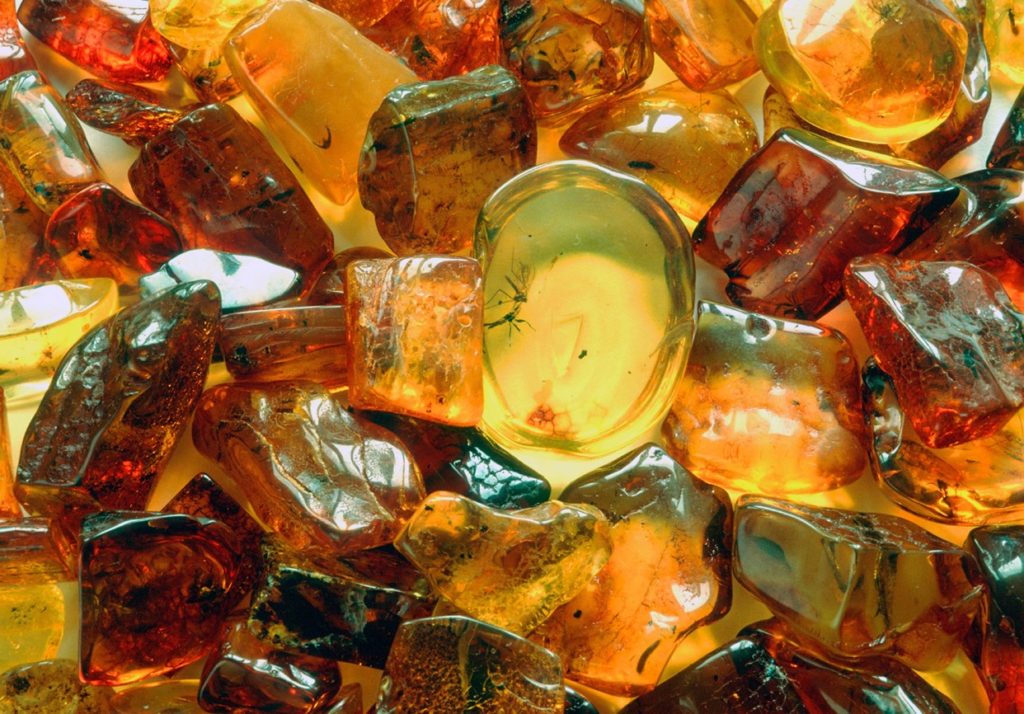
The basis of the mineral contains succinic acid (especially in milky white and yellowish), and additional - a mixture of organic acids. Also included are aluminum, calcium, silicon, iron and some other impurities.
Features:
| Formula | C10H16O + (H2S) |
| Transparency | Miscellaneous: transparent to opaque |
| Hardness | 2 – 2,5 |
| Cleavage | No |
| Density | 1,05 - 1,09 to 1,3 g / cm3 |
| Kink | Crusty, viscous with aging, becomes brittle over time in the open air |
| Brilliance | Resin (can be divided into glassy, frosted and oily) |
| Colours | Brown, red, milky white, yellowish, honey, green, red, rarely blue and black |
| Structure | Amphora |
| Composition |
|
Amber at temperatures up to +150 degrees Celsius acquires softness, +150 - 350 - melts, at higher temperatures burns and disappears, electrifies with friction.
The stone does not have a crystal lattice; it is a polymer that is easily polished. There is no birefringence or dispersion.
Basically, they are cut in cabochon, since it is better not to cut them because of their fragility.
In salt water, amber does not sink, but in fresh water, during long-term storage, it begins to swell. Has the ability to dissolve in a number of acids, alcohol and oils.
Amber deposits

The Baltics are considered one of the main places for the extraction of sun stone. Lithuania is recognized as a supplier of very high quality amber. On the shores of the Baltic Sea, you can even find small stones on your own.
The main deposits are found in Russia, where up to 90% of the world's amber is mined. In the Kaliningrad region, for example, up to 300 tons of the mineral are mined annually. Found amber deposits in smaller quantities on the island of Sakhalin, in the Urals and Siberia.
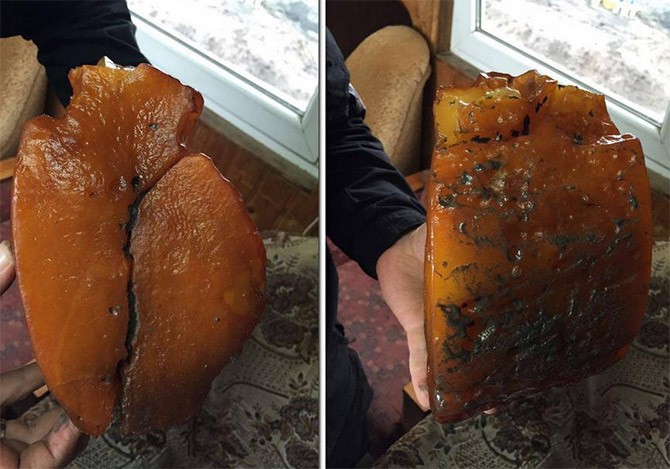
In Ukraine, amber is mined on an area of about 200 km2. More than XNUMX tons of amber are collected every year. Deposits have been found in the Kiev, Volyn, Rivne and Zhytomyr regions.
In total, several hundred deposits are known in the world. The largest among them are in the following countries:
- Burma.
- Dominican Republic.
- Indonesia.
- America (Canada, USA).
- Italy.
- Romania.
- Myanmar
- Mexico.
Extraction is carried out in several ways: with the help of a strong pressure of water, the soil is washed away (industrial method), in coastal waters, in clumps of algae during a storm or large waves, it is possible to find amber on your own (amateur method).
After extraction, amber is carefully polished, cut into pieces, then given a certain shape, polished and polished. The result is a finished product.
Varieties and colors of amber
The classification of amber includes not only color differences, but also the degree of transparency. Gemologists know more than 300 shades of stone. The classic palette ranges from yellow to brown, which is why amber was called the "sun stone". However, there are other beautiful, rare colors created by nature itself. Amber happens:
- orange;
- brownish yellow;
- white;
- blue;
- green;
- black;
- red;
- transparent colorless.
The brownish-yellow mineral is the most common, but the red or "dragon's blood" is very rare. Outwardly, such a gem resembles ruby, therefore highly regarded. The green tint to the gem is given by the admixture of pyrite or algae. The blue nugget is found only in the Dominican Republic. The white mineral is not actually white, but yellowish.
In mineralogy, amber is classified by types, each of which has its own name:
- Glessith. An opaque brown mineral, practically devoid of impurities.
- Kiscellite. Green, olive or yellow gem.
- Bockerite. A stone with high density and elasticity, opaque, reddish-caramel color.
- Krantzite. Immature nugget.
- Succinite. The most common type, gem-quality gem. The color is deep brown, the middle is a rich yellow shade. Contains a large amount of succinic acid.
- Shraufit. The nugget is red or red-yellow in color.
- Gedanite. The most fragile of amber, not amenable to processing.
- Stantienite. Opaque, black-brown, fragile nugget.
- "Overburden Amber". More "mature" stones with a thick weathered layer.
- "Naked Amber". In contrast to the overburden, it is a young, undisturbed mineral. There is either a fossil, unchanging shade, or darkened due to the process of grinding with sea sand.
- Rotten Amber. Intermediate between succinite and gedanite (between fossil and semi-fossil resin).
Often, the remains of the animal or plant world of ancient times, called inclusions, are interspersed inside the amber. Often these are insects, forever stuck in the resin, which has preserved their original appearance in the smallest detail. Such specimens are more valuable. When a stone with inclusions reaches 1 cm or more, it is awarded the status of precious.
There is also Dominican blue amber, which, when burned, does not emit a coniferous aroma, but has a pleasant floral smell, thanks to the resin of the carob tree.
Caribbean amber refracts incident infrared rays in a special way and is characterized by a bluish glow. These stones are considered the most valuable.
The magical properties of amber

It is believed that amber should not be worn by people with unkind thoughts and anger, envy in their hearts. This is a stone of kindness and health, it is able to protect the owner from any negativity and influence of dark forces.
The following values are also known:
- The stone of youth, from which in ancient times they made elixirs that rejuvenate the body.
- Protects from the evil eye and damage.
- Gives vigor and activity.
- Develops intuition.
- Some nations use it to pray for a good harvest.
- A good amulet for women in position.
- Recommended for young girls, drivers, travel enthusiasts and people whose professions are related to research activities: chemists, physicists, geologists and archaeologists, testers and scientists.
A golden hue will help the owner get rid of depression and melancholy, black amber is advised to take on a trip, green amber on a red thread is placed in the child's bed as a talisman.
If the stone is cracked, then you need to wait for trouble, and if it becomes cloudy, then disease.
Interesting: black amber is worn by magicians and sorcerers, considering it the most powerful protector in rituals.
Medicinal properties
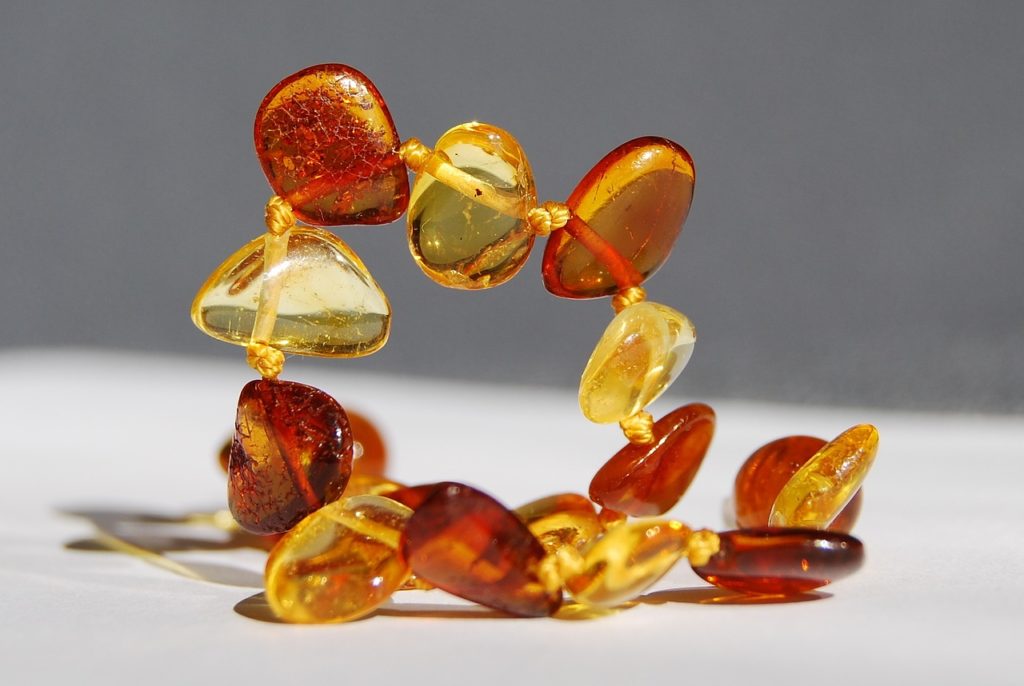
There are no contraindications, amber is suitable for most people. But if there is an unpleasant condition, accompanied by dizziness and nausea, then it is better not to wear a stone.
Suitable earrings, beads, rings and bracelets for permanent wear:
- If a child is put on amber beads, the teeth will climb much easier, the pain will disappear.
- It is useful to wear jewelry with excess weight and metabolic disorders.
- Improves the functioning of the brain and central nervous system, relieves chronic fatigue.
- The brooch will help solve respiratory problems, cure colds, including chronic ones.
- The green stone improves vision and hearing.
- If you have problems with the thyroid gland, it is recommended to wear short beads made of raw stone.
- Green amber will also help with pathologies of the heart and blood vessels, nervous system and gastrointestinal tract.
- To get rid of allergies and rashes, it is enough to wear a bracelet or beads.
It is better to purchase products made from medium-sized minerals.
To restore the function of the stomach and intestines, it is enough to make an infusion of amber. To do this, you need to put a stone in water for 2 weeks, and then drink 50-100 grams daily.
It is recommended to store the liquid in a sunny place in the house.
Who is suitable for the sign of the zodiac
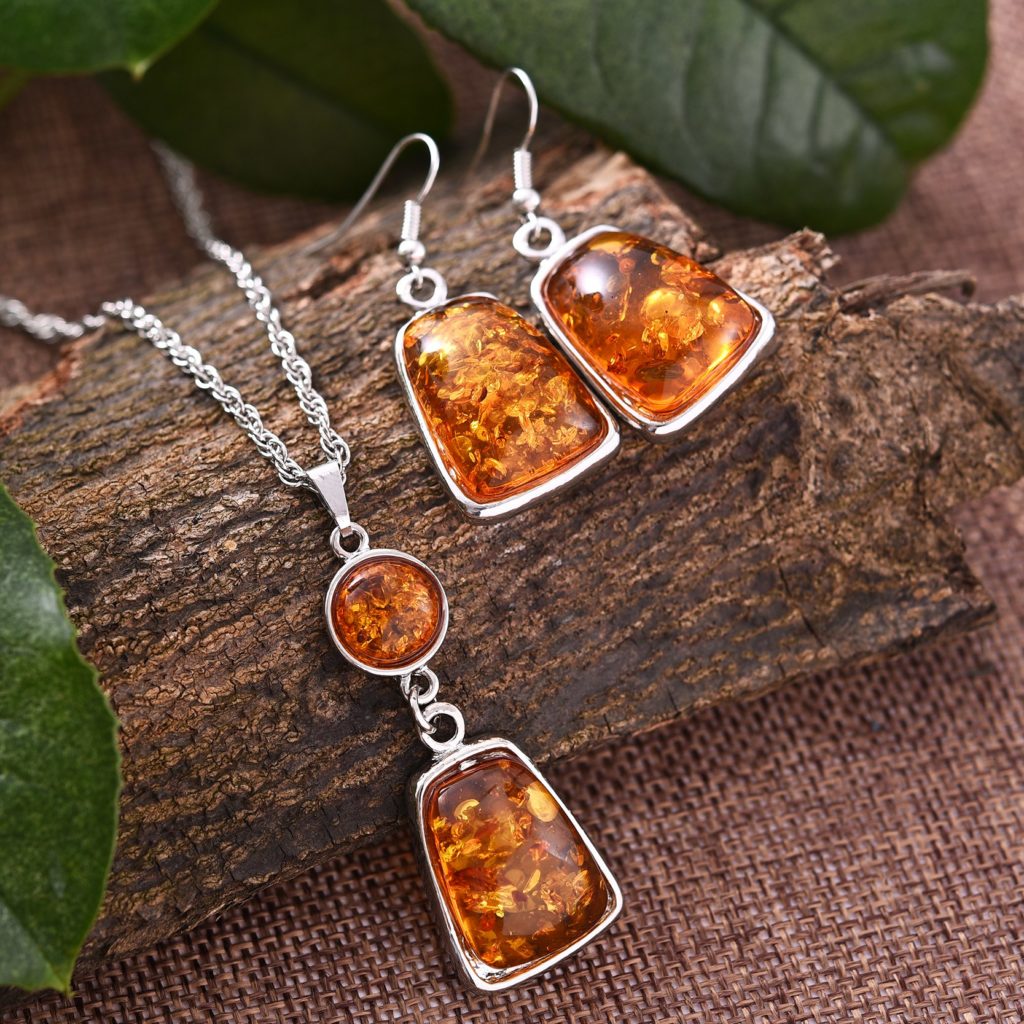
Amber has practically no contraindications according to the horoscope, it goes well with all the signs. The exception is Taurus. But even here you can replace the mineral with a very well-processed or compressed version.
Earrings and rings with amber are especially recommended Leo women, and men of this sign can purchase cufflinks with this mineral.
This is their stone that gives health and strength, develops intuition and protects against the evil eye and negative influences.
"Water" signs (Cancer, Pisces, Scorpio) it is better to choose transparent stones that will benefit in the form of new feelings, clarity, and a surge of strength.
Aquarius it is better to purchase a mineral interspersed with air bubbles. A Capricorns opt for cloudy and delicate yellowish-white options. Gemini to gain balance, you should choose amber of calm shades.
Yellow and golden minerals, symbolizing health and joy, it is desirable to acquire the zodiac sign Virgo, and large specimens are suitable for the Fiery Sagittarius and Aries.
("+++" - the stone fits perfectly, "+" - can be worn, "-" - absolutely contraindicated):
| Zodiac sign | Compatibility |
|---|---|
| Aries | + + + |
| Taurus | + |
| Gemini | + |
| Cancer | + |
| a lion | + + + |
| Virgo | + |
| Scales | + |
| Scorpio | + |
| Sagittarius | + + + |
| Capricorn | + |
| Aquarius | + |
| Pisces | + |
Talismans and charms

This mineral is best worn as a personal item or jewelry, cleaned regularly and allowed to rest. To protect your home, you can purchase a figurine or jewelry box.
In some countries, it is customary to give amber jewelry to loved ones as an amulet and amulet.
Any jewelry will suit women, and men can be presented with cufflinks, amber and silver incense, amber chess for the anniversary, a ring with black amber, a mouthpiece.
In the house, in the form of a talisman, you can hang a picture made of amber chips.

In the folds of clothes or in a secret pocket on a child's clothes, they used to hide an amber bead, which protects from the evil eye and damage. And even now you can wear beads strung on a red thread.
Jewelry with amber
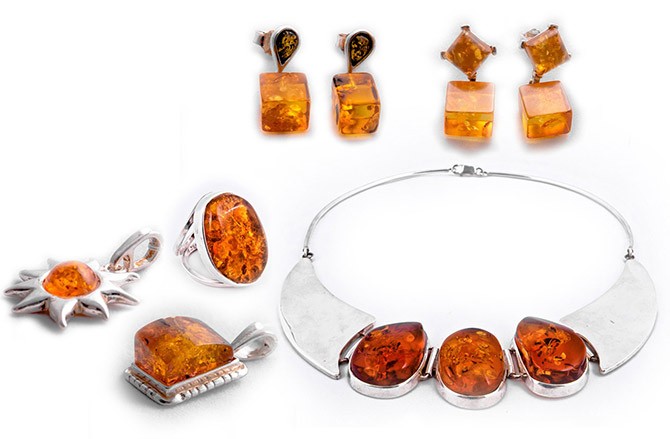
The most acceptable metal for amber is platinum or silver. Brooches, pendants, earrings, pendants, rings, bracelets and cufflinks are made of the mineral.
Green and golden shades are suitable for young, and darker stones for mature ladies.
Other uses of stone
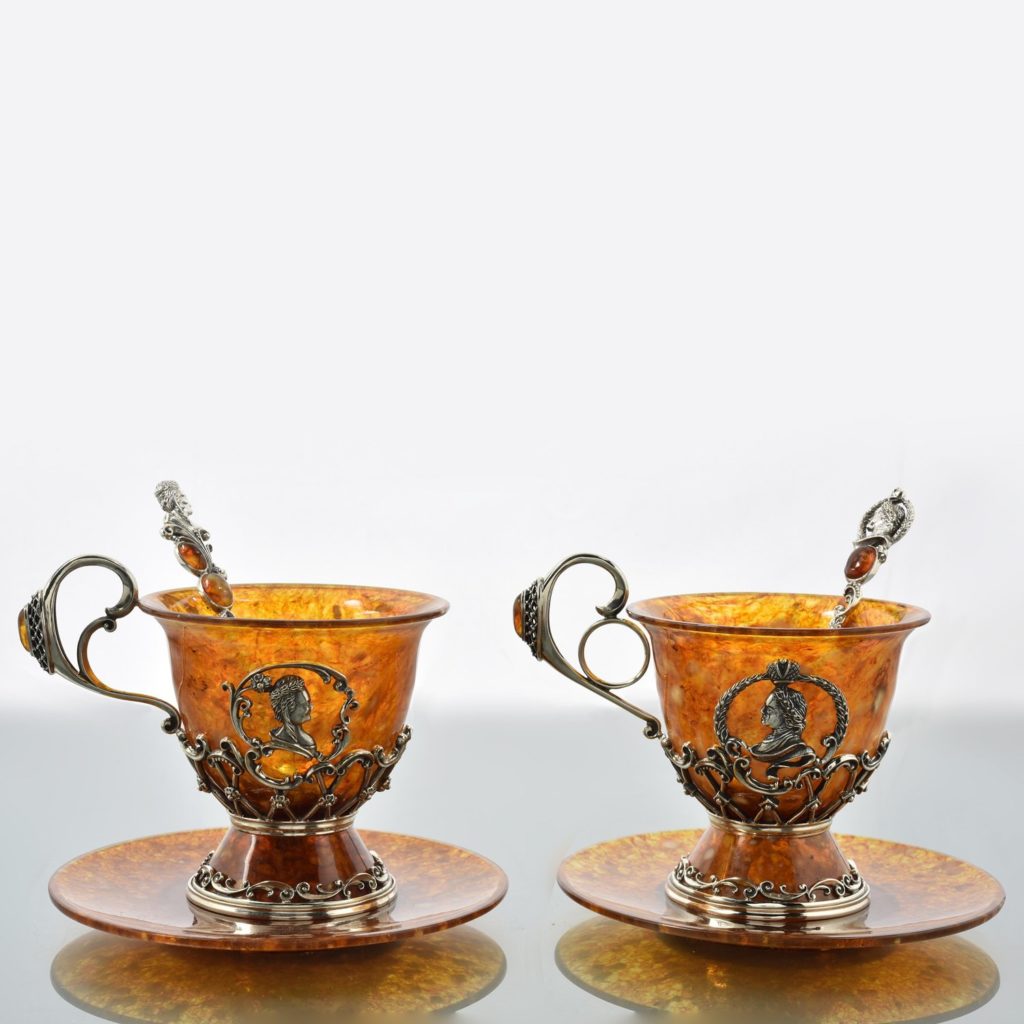
In addition to paintings, amber is used for the manufacture of clocks, dishes, mouthpieces, balls with patterns, frames for mirrors, figurines of animals and birds and boxes.
Waste-free production of amber allows the crumb to be used for creativity. And also the mineral is used for the manufacture of enamels, paints, good insulating material.
In medicine, the stone is used for medicinal purposes: many are familiar with succinic acid, which is especially discounted in preparations.
Amber is also added in the manufacture of medical equipment. Some types are used in agriculture.
Price and care
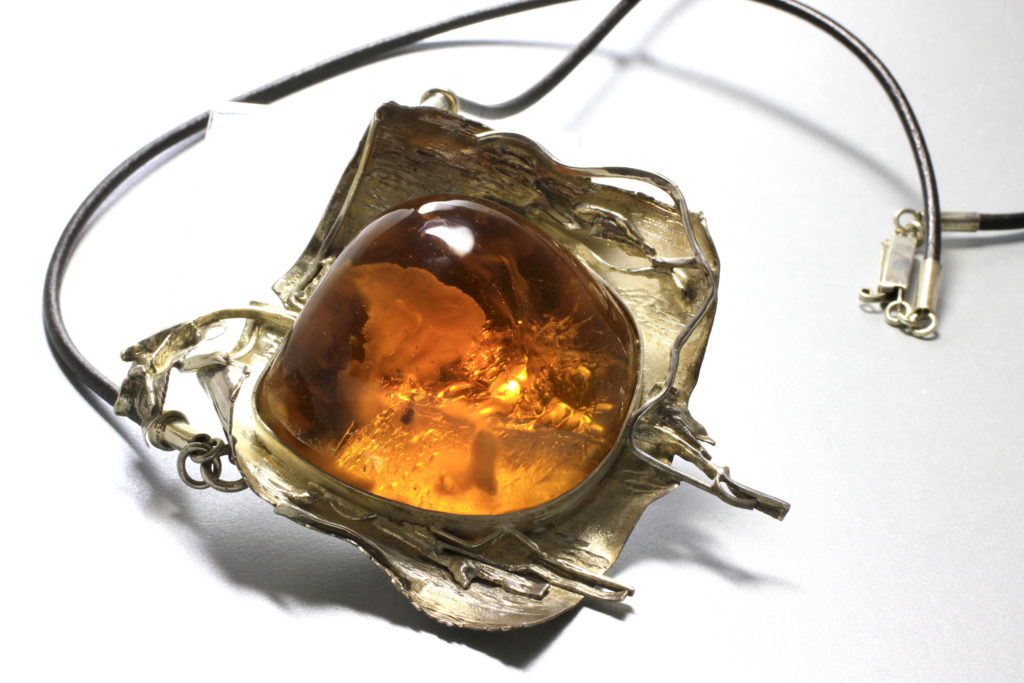
The cost depends on the quality of the stone, the size and the product itself. The rarest and most beautiful can cost from $ 5 to $ 97 per gram.
Amber of the usual yellow shades will not cost more than $ 16 per gram.
Blue, green and red minerals are more expensive.
Storing amber is not difficult:
- Avoid contact with perfume, soap or cosmetics.
- Do not throw.
- Store separately in a box.
- To prevent the stone from darkening, do not leave it in direct sunlight.
- Avoid sudden temperature changes to avoid cracking.
The mineral is rarely contaminated, so it can be cleaned only when necessary.
To do this, tooth powder and paraffin wax should be taken in equal amounts and mixed until smooth. Then apply to the stone and wipe off with a soft cloth.
Fake diamond
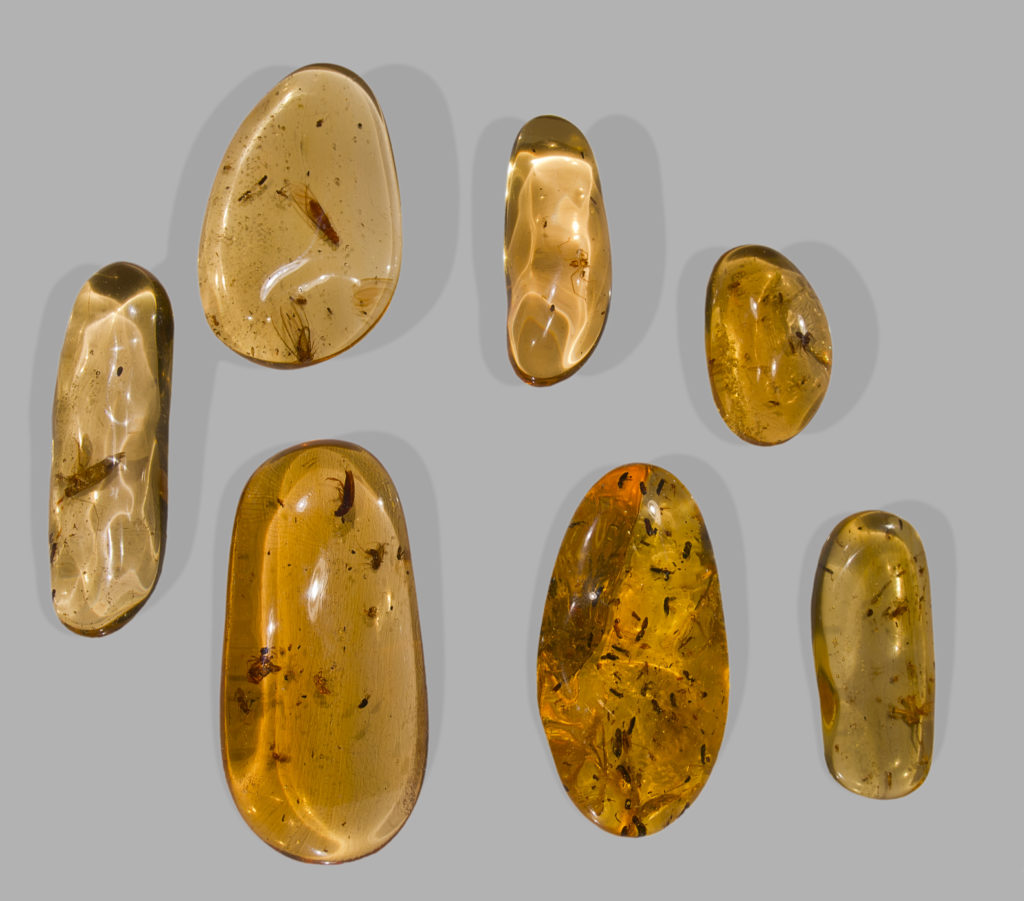
Ornamental similar options are: copal (fossilized resin of legumes) and bernite (amber powder, which is held together with epoxy resin and exposed to high temperatures).
Celluloid is also known, from which knife handles are often made, inexpensive parts for decoration.
Bernite and buranite are also known - acrylic fakes, polyester compounds. Instead of amber, they sometimes sell the mineral simbercite, which has an external similarity.
How to distinguish from fakes
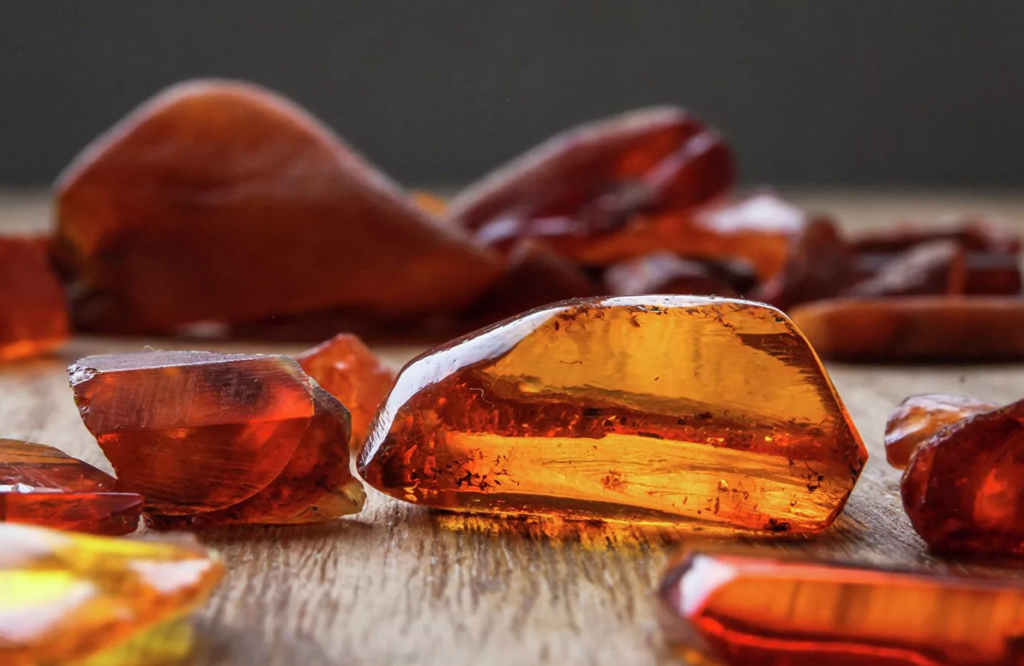
The modern market offers not only a wide selection of natural amber products, but also a selection of imitations and falsifications. There is a certain classification of stones that are not pure amber:
- Pressed amber chips. This imitation is the most natural, not considered a fake at all. But such a stone should be cheaper, and the documents should contain information that the gem is made from amber processing waste.
- Organic imitation. This includes stones created from natural resins of various origins. For example, the resin of the cowrie tree, copal - the resin of angiosperms, burmite and other natural resins.
- Inorganic imitation. There are also many options here - glass, plastic, polystyrene, epoxy resin, polyethylene.
Often, in imitation, inclusions are artificially introduced - various insects, passing off the stone as amber that has been lying in the ground for 30 million years. It is not easy to distinguish such a fake with the naked eye.

There are a number of signs that can help you recognize a natural stone:
- The weight. Glass is too heavy to pass as a natural nugget, and plastic is too light.
- Structure. If you carefully examine the gem in the light, layering or sagging will become noticeable, since the formation of the stone occurred due to the flow of fresh resin onto the already petrified one. There is no such effect in imitations.
- Smell. Fake plastic, copal or epoxy imitation are checked for odor by heating. To do this, a dubious nugget is pierced with a heated needle. Natural amber will exude a pleasant coniferous aroma, while synthetics will give off a pungent "incense". Any other resin will give off a medicinal odor.
- Electrification. Amber can be electrified with a woolen cloth, but dug, plastic, cowrie, or glass cannot. In the case of a fake ambroid, this method will not work.
- Ultraviolet. Under such a light, a natural nugget glows blue, green or white, and a fake one glows orange or does not shine at all.
- Brine. In salt water, a real stone will float, and an imitation will be at the bottom due to its greater density.
The hardest thing to spot is an ambroid fake. Essential oil can help here. It will leave a stain on the surface of an ambroid, but not on amber. Only a jeweler can determine an imitation from a calcined copal, since after refining this resin maximally reflects the properties of amber.
Inclusions are a separate controversial issue. Most often, an already dead insect is placed in fakes, which can be seen by the folded wings and legs. The fossil insect, once trapped in the resin, floundered there to the last.
Therefore, flies and insects look more natural in natural amber. It is possible that some counterfeiters are placed in imitation of live flies, so be vigilant and make a purchase from trusted sellers.
What stones are combined with
Amber is a nugget of Fire. This means that it is absolutely incompatible with Water or Earth. The mineral will suppress the earthly energy, and with the water element, the effect of mutual destruction is created.
Water minerals - Chrysolite, Alexandrite, Opal, Adularia, Topaz and Emerald.
Earth Stones - Malachite, Turquoise, Jasper, Jadeite and Sardonyx.
Fiery cousins:
- Pyrite.
- Coral.
- Zircon.
- Spinel.
- Pyrope.
- Heliodor.
- Diamond.
Interesting Facts

- In Copenhagen the largest piece of amber is kept, weighing 80 kg.
- In the world 3 stones are known, the cost of which exceeds 10 thousand dollars: in the first there is a chameleon 7 cm long, in the second - a lizard 10 cm, in the third - you can see a frozen frog.
- The famous amber room was made for the Prussian king Frederick I, and then became the property of Peter I. During the Great Patriotic War, the room was transported to Tsarskoe Selo, and then disappeared without a trace during the occupation. According to some reports, it was transported secretly by the Germans, but some are convinced that the unique treasure was burned down.
